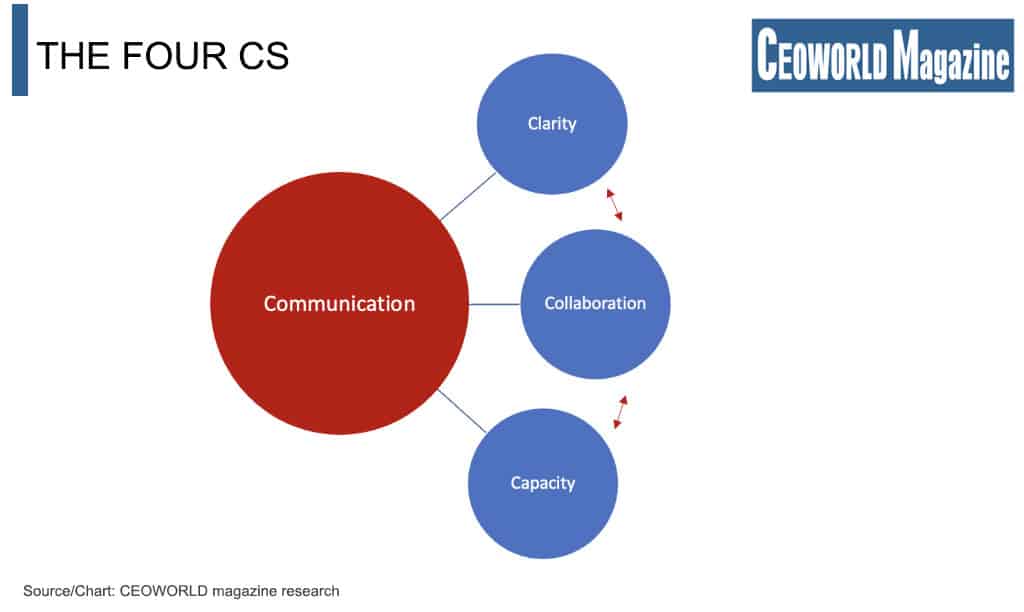2024: Time to Answer the Alarm

In 2022, Grammarly/Harris Poll conducted a study that sounded an alarm. The findings revealed that companies in the US alone were losing $1.2 trillion annually because of ineffective communication. The following year, a second look confirmed what the researchers suspected: This problem won’t improve anytime soon, mainly because most business leaders and knowledge workers see themselves as good communicators.
Suppose no one is willing to look in the mirror (or hold one up for them). In that case, it stands to reason that companies everywhere (as there is no reason to believe this is a US problem alone) will continue to donate to the ICF (Ineffective Communication Fund) at their financial, cultural, and operational peril.
The Intentionality Imperative
In the hit HBO series The Newsroom, Will McAvoy (played by Jeff Daniels) said, “The first step in solving any problem is recognizing there is one.” For leaders, this means addressing three immutable truths:
- Receipt of the message by the audience, as intended, is up to the sender.
- A free flow of information is not what you would like to have; it’s a cultural and operational imperative.
- You need a communication system that matches your situation and requirements.
Receipt of the message by the audience, as intended, is up to the sender.
Years ago, during a trip to the National Gallery of Art, I saw a painting that depicted a story of a general who was relieved of his command – not because he gave the wrong order to his troops, but because the order was misinterpreted. His superiors recognized that it’s the leader’s responsibility to ensure an order is clearly understood before taking action. A similar philosophy is employed when a runner passes the baton in a relay race. It’s up to the person passing the baton to ensure the receiver has it in her grasp before letting her teammate run with it. Business leaders must accept this responsibility in the same way.
A free flow of information is not what you would like to have; it’s a cultural and operational imperative.
In service of the organization’s mission, there is no greater responsibility for an employee than to speak truth to power. The employees must use their gifts and share their unique perspectives. Conversely, it’s up to the leaders to create an environment that invites and encourages employees to speak their truth. Timely clarity for all involved (up, down, and sideways) is the communication gift that keeps on giving.
You need a communication system that matches your situation and requirements.
The more a company grows, the more complicated communication can become. Leaders respond by adding communication channels, volume, and frequency to the internal dialogue. When companies add, they rarely take away. As a result, communication doesn’t improve; it gets worse. Employees inadvertently drop balls, misinterpret messages, or don’t receive them at all. Communication overload compromises clarity, collaboration, and capacity, which costs you credibility, clients, and cash.
The Four Cs: Clarity, Communication, Collaboration, Capacity
That said, the more intentional you are about building and continually updating your communication system, the more you can avoid the myriad challenges of ineffective communication. Doing so will involve engaging your people at all levels in deep dialogue about the 4 Cs.
- Clarity
During Peernovation workshops inside companies, the most common response to a CEO asking how they can help the employees be even more successful in their work is clarity. This result begs the following questions: Are your employees clear about the company’s values and strategic goals? Do they understand how their work connects to both? Do they know who they can go to for help? Do they know if they are meeting the expectations for their roles? - Communication
Even if there is clarity at a high level, companies of all sizes can have daily communication challenges. What may have worked in the past is not scalable for growing companies. For larger companies, silos can become inevitable, making it nearly impossible to leverage the synergies that you already have at your fingertips. Poor communication impacts the other three Cs, and each affects the others. - Collaboration
Even when there is a high level of clarity and efficient communication, are your employees working together as effectively as they can as a team, both departmentally and cross-functionally? Mindset can play a significant role here. For example, when your executive leadership team members meet, are they wearing their department hats or enterprise hats? If it’s the former, your cross-functional team is likely a dysfunctional one. - Capacity
While deficiencies in clarity, communication, and collaboration (singularly or in combination) can impact organizational capacity, a lack of capacity due to unrealistic workloads will affect the other three.
In some companies, poor collaboration is the culprit; in others, it’s a lack of clarity. A more strategic approach to internal communication will create greater clarity, promote ease of collaboration, and give people hours in their week back, which will increase your organizational capacity AND improve employee mental health.

Summary
In addition to the sobering results from Grammarly/Harris Poll about ineffective communication, Edelman Trust Barometer asked employees this in 2019: “How do you typically find out about what is really happening within your organization?” Of all the sources of information available from and about the company, the top response was: “Other employees.” It may not be where they first hear the information, but it is where they find out what it means. If that doesn’t make you think it’s time to answer the alarm and take a more holistic approach to your communication in 2024, I don’t know what will. It’s time to take all the currencies you are sending to ICF and reclaim them for your company and your people.
Have you read?
Top 50 global artists list, 2023: These are the most successful living artists in the world.
These Are The Most Popular Songs For Workplace Productivity.
Twenty-five of the world’s oldest billionaires in 2023 ranked.
Ranked: Countries That Produce the Most Carbon Dioxide (CO2), 2023.
Ranked: These Are The Most Desirable Jobs in the World, 2023.
Ranked: U.S. states by the number of billionaires, 2023.
Bring the best of the CEOWORLD magazine's global journalism to audiences in the United States and around the world. - Add CEOWORLD magazine to your Google News feed.
Follow CEOWORLD magazine headlines on: Google News, LinkedIn, Twitter, and Facebook.
Copyright 2025 The CEOWORLD magazine. All rights reserved. This material (and any extract from it) must not be copied, redistributed or placed on any website, without CEOWORLD magazine' prior written consent. For media queries, please contact: info@ceoworld.biz








